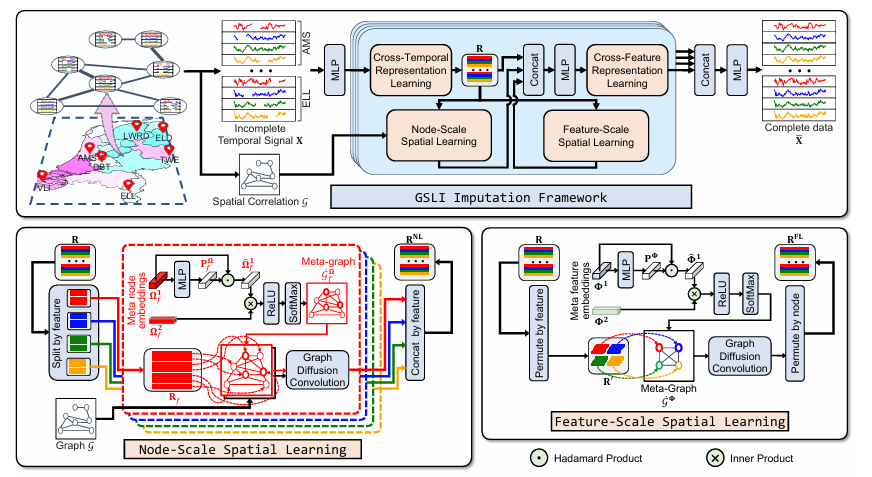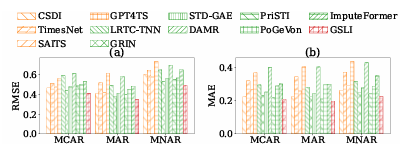Spatio-temporal data Management involves the analysis of information collected in time and space, often through sensors. This data is crucial for pattern discovery and prediction. However, missing values pose a problem and make analysis difficult. These gaps can often create inconsistencies with the data set, causing more difficult analysis. Relationships between characteristics, such as environmental or physical factors, can be complex and influenced by geographic context. Accurately capturing these relationships is critical, but remains challenging due to different trait correlations and the limitations of existing methods, which struggle to address these complexities effectively.
Current methods for addressing missing values in spatio-temporal data rely on fixed spatial graphs and graph neural networks (GNN) to capture spatial dependencies. These approaches assume that spatial relationships between entities are uniform across different locations. These approaches do not consider that features recorded by sensors often bear different relationships in relation to their respective locations and contexts. Therefore, these approaches do not adequately manage and represent the different complex spatial relationships of various features, leading to incorrect estimates regarding the problems of missing information and the integration of detailed temporal and spatial interconnections.
To address the challenges of spatio-temporal imputation, researchers from Nankai University and Harbin Institute of technology, Shenzhen, China, proposed the multiscale Graph Structure Learning (GSLI) Framework. This framework adapts to spatial correlations by combining two approaches: node scale learning and feature scale learning. Node-scale learning focuses on the global spatial dependencies of individual features, while feature-scale learning discovers spatial relationships between features within a node. Unlike conventional methods that rely on static structures, this framework targets feature heterogeneity and integrates spatiotemporal correlations.

The framework used static graphics to represent spatial data and temporal cues for time-based information, with missing data indicated by masks. Node-scale learning refines embeddings using metanodes to highlight influential nodes, forming metagraphs for feature-specific spatial dependencies. Feature-scale learning produces metagraphs that capture spatial relationships between features across nodes. This design attempts to capture dependencies between features and between times, but at the cost of computational complexity.
The researchers evaluated the performance of GSLI using a Intel Xeon Silver 4314 Processor and NVIDIA RTX 4090 GPU in six Real-world spatio-temporal data sets with missing values. Adjacency matrices were constructed when not provided and missing values lacking ground truth were excluded. Imputation accuracy was assessed using RMSE and MAE metrics under various missing rates, including mcare, SEAand MNAR. GSLI outperformed state-of-the-art methods on all data sets by effectively capturing spatial dependencies through graph structures. Its ability to model intertemporal and feature dependencies allowed for superior adaptability to various scenarios, with results averaged over five assays that demonstrate consistent accuracy even with increasing missing rates or mechanisms.

In conclusion, the proposed framework advances spatio-temporal imputation by addressing feature heterogeneity and leveraging multi-scale graph structure learning to improve accuracy. Therefore, this work has shown, on six real-world data sets, that it performs better than more heuristic techniques based on static spatial graphs and is robust to variation. This framework can act as a foundation for future research, inspiring advances that reduce computational complexity, handle larger data sets, and enable real-time imputation for dynamic systems.
Verify he Paper. All credit for this research goes to the researchers of this project. Also, don't forget to follow us on <a target="_blank" href="https://twitter.com/Marktechpost”>twitter and join our Telegram channel and LinkedIn Grabove. Don't forget to join our SubReddit over 60,000 ml.
UPCOMING FREE ai WEBINAR (JANUARY 15, 2025): <a target="_blank" href="https://info.gretel.ai/boost-llm-accuracy-with-sd-and-evaluation-intelligence?utm_source=marktechpost&utm_medium=newsletter&utm_campaign=202501_gretel_galileo_webinar”>Increase LLM Accuracy with Synthetic Data and Assessment Intelligence–<a target="_blank" href="https://info.gretel.ai/boost-llm-accuracy-with-sd-and-evaluation-intelligence?utm_source=marktechpost&utm_medium=newsletter&utm_campaign=202501_gretel_galileo_webinar”>Join this webinar to learn practical information to improve LLM model performance and accuracy while protecting data privacy..
Divyesh is a Consulting Intern at Marktechpost. He is pursuing a BTech in Agricultural and Food Engineering from the Indian Institute of technology Kharagpur. He is a data science and machine learning enthusiast who wants to integrate these leading technologies in agriculture and solve challenges.
<script async src="//platform.twitter.com/widgets.js” charset=”utf-8″>






